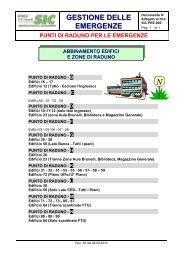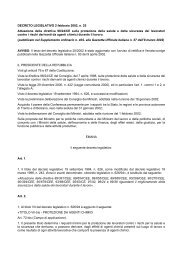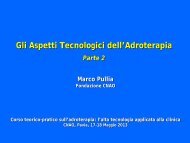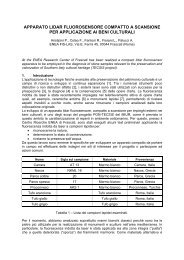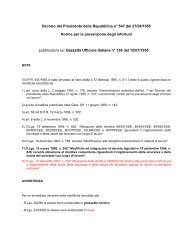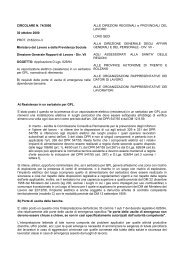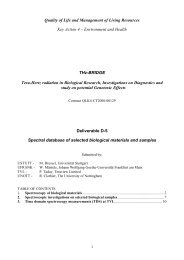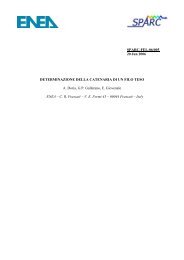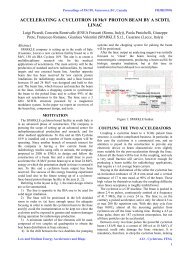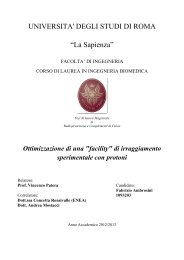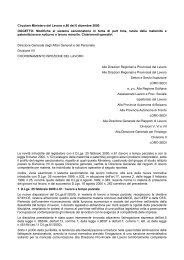Theory, Design and Tests on a Prototype Module of a Compact ...
Theory, Design and Tests on a Prototype Module of a Compact ...
Theory, Design and Tests on a Prototype Module of a Compact ...
Create successful ePaper yourself
Turn your PDF publications into a flip-book with our unique Google optimized e-Paper software.
86 5. RADIOFREQUENCY MEASUREMENT<br />
tank # cell type left [mm] right [mm]<br />
1 AC +2.3 +7.6<br />
CC +0.3 +7.2<br />
2 AC +5.0 +6.2<br />
CC +0.3 +7.2<br />
3 AC +5.0 +6.8<br />
CC +0.3 +7.2<br />
4 AC out +6.0<br />
CC +0.3 +7.2<br />
Table 5.1. Tuners positi<strong>on</strong>s for the bead pulling <strong>of</strong> figure<br />
5.14.<br />
Since all the bead pulling measurement was made feeding the module<br />
by the wave-guide, it was not possible to measure the first nearest<br />
mode stop-b<str<strong>on</strong>g>and</str<strong>on</strong>g>. This stop-b<str<strong>on</strong>g>and</str<strong>on</strong>g> is related to a tilt-like behavior in the<br />
resp<strong>on</strong>se, since the nearest modes have a linear behavior from the first<br />
cell to the last <strong>on</strong>e <str<strong>on</strong>g>and</str<strong>on</strong>g> have a null in the central cavity; this means<br />
that it is not possible to feed <str<strong>on</strong>g>and</str<strong>on</strong>g> to measure these modes from the<br />
wave-guide at a recognizable level.<br />
Last, in the table 5.1 the tuners positi<strong>on</strong>s for the figure 5.14 are<br />
shown. Some comments <strong>on</strong> those values are necessary. For each tank,<br />
two lines <strong>of</strong> tuners are available for each type <strong>of</strong> cell 13 . Here, the left<br />
side is the <strong>on</strong>e <strong>on</strong> the left when <strong>on</strong>e looks the module from the first tank<br />
to the fourth <strong>on</strong>e. It is also possible to act <strong>on</strong> <strong>on</strong>e side at a time. The<br />
values shown represents the length <strong>of</strong> the part <strong>of</strong> the tuners that juts<br />
out <strong>of</strong> the tank side wall; again, this is not important for our purposes,<br />
since <strong>on</strong>ly relative displacement are relevant. In the table out means<br />
that the tuner are completely out <str<strong>on</strong>g>and</str<strong>on</strong>g> the end side <strong>of</strong> the tuner does<br />
not penetrate in the inner surface <strong>of</strong> the cavity. In the tuning process,<br />
the tuners for each tank have been moved all at the same time, as each<br />
tank should be <strong>on</strong>e accelerating cavity <str<strong>on</strong>g>and</str<strong>on</strong>g> <strong>on</strong>e coupling cavity <str<strong>on</strong>g>and</str<strong>on</strong>g><br />
this fact has simplified very much the procedure. C<strong>on</strong>sider the bead<br />
pulling measurement <strong>of</strong> figure 5.15. The <strong>on</strong>ly interventi<strong>on</strong> was to push<br />
the tuners <strong>of</strong> ACs <strong>on</strong> the right side <strong>of</strong> tank #1 inside <strong>of</strong> +0.3 mm,<br />
because before the level <strong>of</strong> this tank was very low. Of course, the little<br />
displacement does not change dramatically the situati<strong>on</strong>, but it is in<br />
the right directi<strong>on</strong> since the level <strong>of</strong> tank #1 was increased. The π/2<br />
frequency was increased to 2997.01 MHz <str<strong>on</strong>g>and</str<strong>on</strong>g> this was clear because<br />
the res<strong>on</strong>ant frequencies <strong>of</strong> ACs <strong>of</strong> tank #1 were increased. The Bump<br />
stop-b<str<strong>on</strong>g>and</str<strong>on</strong>g> was decreased to SBB = +201 kHz <str<strong>on</strong>g>and</str<strong>on</strong>g> this was due to the<br />
fact that the mean frequencies <strong>of</strong> ACs increased where the <strong>on</strong>es <strong>of</strong> the<br />
CCs remained c<strong>on</strong>stant. In figure 5.16 is shown a bead pulling made<br />
13 A lines <strong>of</strong> tuners is c<strong>on</strong>stituted by a number <strong>of</strong> tuners that move together.



